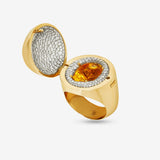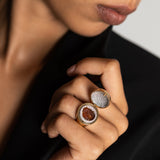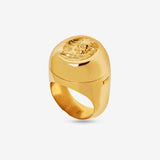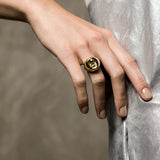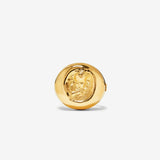VENUS' WOMB RING
ORIGINAL ANTIQUITY
CLASSICAL · ROME
We attend all our customers personally. Please leave us your contact details for information and sales.
We attend all our customers personally. Please leave us your contact details for information and sales.
DESCRIPTION
ORIGINAL ROMAN GLASS PASTE INTAGLIO (200 AD) · 2000 years old glass paste is a delicate material. As a contemporary womb, our locket ring protects this baby Cupid.
The interior encapsulates the gem with a diamond micro pave set in platinum. The golden exterior frame features a 3D print of the intaglio, and is open on the inside to let the sun bring this baby to life.
-
Adaptable size 51 (EUR)
-
18k yellow gold
-
Diamond micro pave set in platinum
-
VVS G grade diamonds. Total weight 1.29 carats
-
Exterior 2.0cm/0.79” x 1.9cm/0.75”
-
Weight 29.7gr

ROMAN GLASS PASTE INTAGLIO (200 AD)
The classical history of gem-engraving is known to begin in the 6th century BC, as new materials and techniques became available to the Greek artist, mainly the use of a cutting wheel and drill, driven by a bow. The Romans added abrasive powder to work a greater variety of coloured translucent stones coming from the East and Egypt. Later, new production techniques made glass paste a popular middle class surrogate for gems.
Both gem and glass paste intaglios were widely used in signet rings, intended to represent the owner as a marker of personal identity, playing a role in contract signing and money lending. They represented a wide range of pictorial references like gods, politicians and even self-portraits. Cupid (Eros) became a widespread art theme throughout the 1st and 2nd century AD.
Roman glass paste intaglios were popular as of the 1st century AD. Here go some museum references, similar in imagery, material and colour.



-
L. M. Yarrow, Markers of identity for non-elite romans: a prolegomenon to the study of glass paste intaglios
-
C. Plinii Secundi (Pliny the Elder), Naturalis historiae (Natural history)
-
Apuleius, Asinus aureus (The golden ass)
Acquired at an antiquities dealer in Hamburg, legally exported under the German and European legislation for export of cultural goods. Authenticity has been certified by Dr. A.K. and Dr. M.H.
This intaglio originates from the Prof. H. Brosch collection, acquired in the years 1960 to 1975. The collection forms a systematic cross-section of the variety of topics of ancient intaglios and has been worked on extensively with scientific claims.
VENUS' WOMB
Love comes in many forms and symbols, none as strong as the love of a mother for her fragile baby. This is a story about ancient gods, about fragile glass and strong hard diamonds, about a baby antiquity protected inside a contemporary womb, about blindness and light, about purity, and ultimately about love.
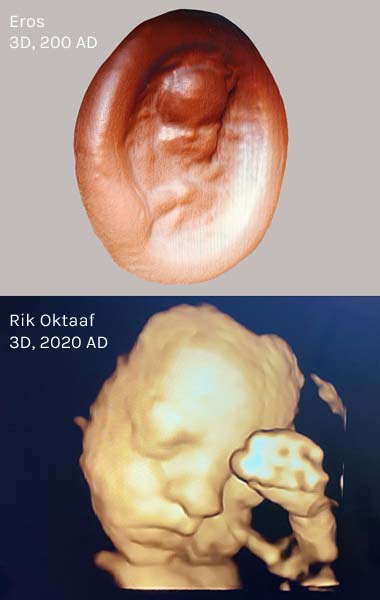
From his early Greek origins as a primordial god, the myth of Eros gradually evolved into the Roman Cupid, baby son of Venus. In the 2nd century AD, Cupid rose to prominence via Platonicus’ tale of Cupid and Psyche in the only ancient Roman novel (ancient novel, how is that for a contradictio in terminis?). In the story of Cupid and Psyche the vulnerability of an arrow wound turns into blind, unconditional love, and eventually conquers death.
In parallel, the early Roman Empire of the 1st and 2nd century AD saw the appearance of translucent glass in domestic and ornamental objects. In jewelry, non-elite Romans replaced precious gemstones in signet seal rings by coloured glass paste. These glass intaglios were used as a marker of identity, covering a wide range of pictorial representations. They are an artistic legacy of the so important Roman popular class, often overseen in the history of conquests and emperors.
This Roman love God stands in stark contrast to his glass paste signet form: strong love vs. fragile glass, pure love vs. imperfect heated sand, blind love vs. translucent intaglio. And so we designed a contemporary womb for this ancient glass baby: a diamond play of protection and light.
Venus’ womb is a unique creation to celebrate the unique creation of life.
PS - While we were building our brand I was expecting a baby boy, Rik Oktaaf. The same week the 2000 years old baby Cupid was 3D scanned, we saw Rik for the first time through a 3D echography.






